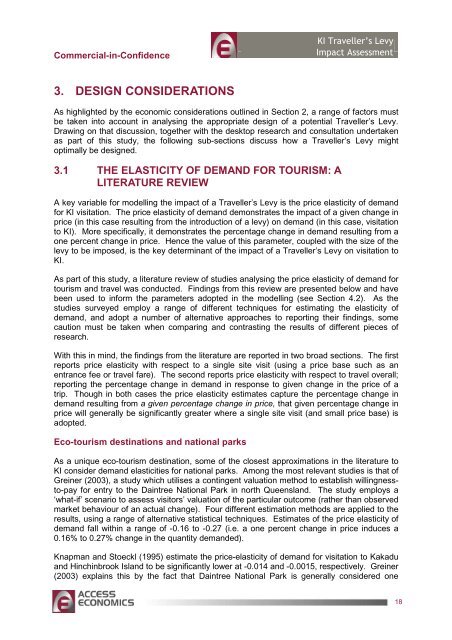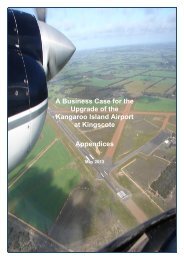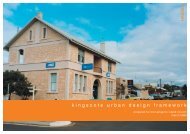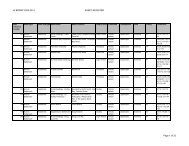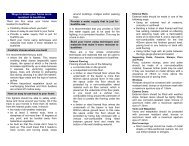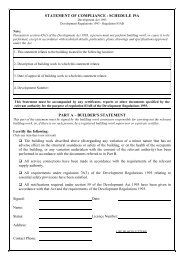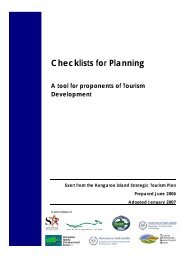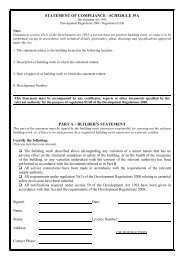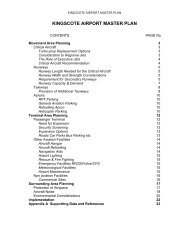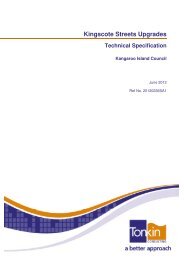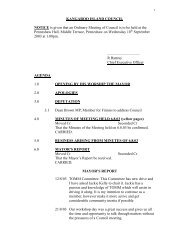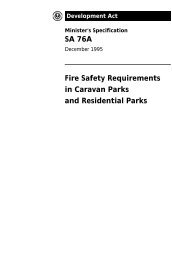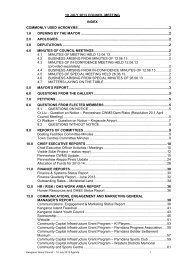KI Traveller's Levy Economic Impact Assessment - Kangaroo Island ...
KI Traveller's Levy Economic Impact Assessment - Kangaroo Island ...
KI Traveller's Levy Economic Impact Assessment - Kangaroo Island ...
You also want an ePaper? Increase the reach of your titles
YUMPU automatically turns print PDFs into web optimized ePapers that Google loves.
Commercial-in-Confidence<br />
<strong>KI</strong> Traveller’s <strong>Levy</strong><br />
<strong>Impact</strong> <strong>Assessment</strong><br />
3. DESIGN CONSIDERATIONS<br />
As highlighted by the economic considerations outlined in Section 2, a range of factors must<br />
be taken into account in analysing the appropriate design of a potential Traveller’s <strong>Levy</strong>.<br />
Drawing on that discussion, together with the desktop research and consultation undertaken<br />
as part of this study, the following sub-sections discuss how a Traveller’s <strong>Levy</strong> might<br />
optimally be designed.<br />
3.1 THE ELASTICITY OF DEMAND FOR TOURISM: A<br />
LITERATURE REVIEW<br />
A key variable for modelling the impact of a Traveller’s <strong>Levy</strong> is the price elasticity of demand<br />
for <strong>KI</strong> visitation. The price elasticity of demand demonstrates the impact of a given change in<br />
price (in this case resulting from the introduction of a levy) on demand (in this case, visitation<br />
to <strong>KI</strong>). More specifically, it demonstrates the percentage change in demand resulting from a<br />
one percent change in price. Hence the value of this parameter, coupled with the size of the<br />
levy to be imposed, is the key determinant of the impact of a Traveller’s <strong>Levy</strong> on visitation to<br />
<strong>KI</strong>.<br />
As part of this study, a literature review of studies analysing the price elasticity of demand for<br />
tourism and travel was conducted. Findings from this review are presented below and have<br />
been used to inform the parameters adopted in the modelling (see Section 4.2). As the<br />
studies surveyed employ a range of different techniques for estimating the elasticity of<br />
demand, and adopt a number of alternative approaches to reporting their findings, some<br />
caution must be taken when comparing and contrasting the results of different pieces of<br />
research.<br />
With this in mind, the findings from the literature are reported in two broad sections. The first<br />
reports price elasticity with respect to a single site visit (using a price base such as an<br />
entrance fee or travel fare). The second reports price elasticity with respect to travel overall;<br />
reporting the percentage change in demand in response to given change in the price of a<br />
trip. Though in both cases the price elasticity estimates capture the percentage change in<br />
demand resulting from a given percentage change in price, that given percentage change in<br />
price will generally be significantly greater where a single site visit (and small price base) is<br />
adopted.<br />
Eco-tourism destinations and national parks<br />
As a unique eco-tourism destination, some of the closest approximations in the literature to<br />
<strong>KI</strong> consider demand elasticities for national parks. Among the most relevant studies is that of<br />
Greiner (2003), a study which utilises a contingent valuation method to establish willingnessto-pay<br />
for entry to the Daintree National Park in north Queensland. The study employs a<br />
‘what-if’ scenario to assess visitors’ valuation of the particular outcome (rather than observed<br />
market behaviour of an actual change). Four different estimation methods are applied to the<br />
results, using a range of alternative statistical techniques. Estimates of the price elasticity of<br />
demand fall within a range of -0.16 to -0.27 (i.e. a one percent change in price induces a<br />
0.16% to 0.27% change in the quantity demanded).<br />
Knapman and Stoeckl (1995) estimate the price-elasticity of demand for visitation to Kakadu<br />
and Hinchinbrook <strong>Island</strong> to be significantly lower at -0.014 and -0.0015, respectively. Greiner<br />
(2003) explains this by the fact that Daintree National Park is generally considered one<br />
18


